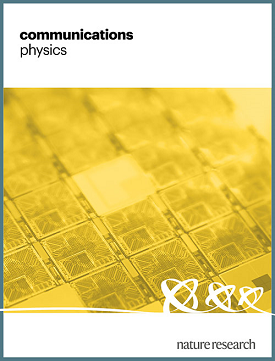Circuit-noise-resilient virtual distillation
IF 5.4
1区 物理与天体物理
Q1 PHYSICS, MULTIDISCIPLINARY
引用次数: 0
Abstract
Quantum error mitigation (QEM) is vital for improving quantum algorithms’ accuracy on noisy near-term devices. A typical QEM method, called Virtual Distillation (VD), can suffer from imperfect implementation, potentially leading to worse outcomes than without mitigation. To address this, we introduce Circuit-Noise-Resilient Virtual Distillation (CNR-VD), which includes a calibration process using simple input states to enhance VD’s performance despite circuit noise, aiming to recover the results of an ideally conducted VD circuit. Simulations show that CNR-VD significantly mitigates noise-induced errors in VD circuits, boosting accuracy by up to tenfold over standard VD. It provides positive error mitigation even under high noise, where standard VD fails. Furthermore, our estimator’s versatility extends its utility beyond VD, enhancing outcomes in general Hadamard-Test circuits. The proposed CNR-VD significantly enhances the noise-resilience of VD, and thus is anticipated to elevate the performance of quantum algorithm implementations on near-term quantum devices. This study focuses on reducing noise in the circuit used in the quantum error mitigation method called Virtual Distillation (VD). The authors introduce an approach which significantly enhances the noise tolerance of VD and improves the accuracy by an order of magnitude compared to the standard VD.

抗电路噪声虚拟蒸馏
量子误差缓解(QEM)对于提高量子算法在嘈杂的近期设备上的准确性至关重要。一种典型的 QEM 方法被称为虚拟蒸馏 (VD),这种方法的实现可能并不完美,有可能导致比不减轻误差更糟糕的结果。为了解决这个问题,我们引入了电路噪声弹性虚拟蒸馏(CNR-VD),其中包括一个使用简单输入状态的校准过程,以提高虚拟蒸馏的性能(尽管存在电路噪声),目的是恢复理想的虚拟蒸馏电路的结果。模拟结果表明,CNR-VD 能显著减轻 VD 电路中由噪声引起的误差,与标准 VD 相比,精度最多可提高 10 倍。即使在标准 VD 失效的高噪声条件下,CNR-VD 也能积极缓解误差。此外,我们的估算器的多功能性还将其用途扩展到了 VD 之外,提高了一般 Hadamard-Test 电路的结果。所提出的 CNR-VD 显著增强了 VD 的抗噪能力,因此有望提升近期量子器件上量子算法实现的性能。这项研究的重点是减少量子错误缓解方法--虚拟蒸馏(VD)--中使用的电路中的噪声。作者介绍了一种方法,与标准 VD 相比,该方法显著增强了 VD 的噪声容限,并将精度提高了一个数量级。
本文章由计算机程序翻译,如有差异,请以英文原文为准。
求助全文
约1分钟内获得全文
求助全文
来源期刊

Communications Physics
Physics and Astronomy-General Physics and Astronomy
CiteScore
8.40
自引率
3.60%
发文量
276
审稿时长
13 weeks
期刊介绍:
Communications Physics is an open access journal from Nature Research publishing high-quality research, reviews and commentary in all areas of the physical sciences. Research papers published by the journal represent significant advances bringing new insight to a specialized area of research in physics. We also aim to provide a community forum for issues of importance to all physicists, regardless of sub-discipline.
The scope of the journal covers all areas of experimental, applied, fundamental, and interdisciplinary physical sciences. Primary research published in Communications Physics includes novel experimental results, new techniques or computational methods that may influence the work of others in the sub-discipline. We also consider submissions from adjacent research fields where the central advance of the study is of interest to physicists, for example material sciences, physical chemistry and technologies.
 求助内容:
求助内容: 应助结果提醒方式:
应助结果提醒方式:


